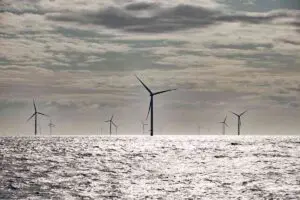The world’s first commercial offshore floating solar PV power plant has been commissioned off the east of China and is also the world’s first floating PV plant to be integrated with offshore wind.
Installed off the eastern Chinese province of Shandong, the floating PV plant was commissioned last week by the world’s largest PV asset owner, China’s State Power Investment Corporation (SPIC).
The two floating PV arrays boast an installed capacity of just 0.5MW and are connected to the transformer on a SPIC-owned wind turbine. The newly commissioned floating PV system thus delivers power to the grid through the wind farm’s existing submarine cable.
Designed by Norwegian solar technology developer Ocean Sun, the floating PV plant (FPV) is the company’s contribution towards revolutionising floating solar power production.
Using a thin polymer membrane to float customised PV modules, Ocean Sun’s floating PV plant delivers a number of benefits over other floating solar options. Utilising the overall lowest material usage of any floating PV system, the technology therefore enables the lowest overall levelized cost of electricity (LCoE).
Installation of the system is also billed as being simple, safe, and quick, and increases efficiency from direct water cooling. Ocean Sun also claims that its floating PV system has been proven robust in high wind, waves, and strong currents.
Before the demonstration pilot can be called a success, though, the floating system will first need to prove itself through a whole typhoon season.
Børge Bjørneklett, CEO and founder of Ocean Sun, explained earlier this year that the waters off Shandong Province “see annual typhoons with challenging sea state, and all involved parties are aware of the risks. In all circumstances, Ocean Sun will improve our product with learnings from this exposed site.”
Once the pilot project has shown its robustness through an entire typhoon season, there are plans to connect the remaining wind turbines off the Shandong coast with floating PV systems. Upon completion, a total of 20MWp of floating solar would be connected to the grid some time during 2023.
“This is a true milestone for Ocean Sun, and for the floating solar industry,” said Bjørneklett last week.
“The successful project funded by SPIC and constructed using the Ocean Sun solution shows how the common goal of reducing greenhouse CO2 emissions will be achieved with development across borders.
“We are excited to continue working closely with SPIC through the Ocean Sun team based in China.”









